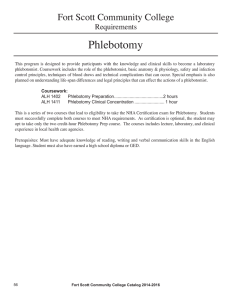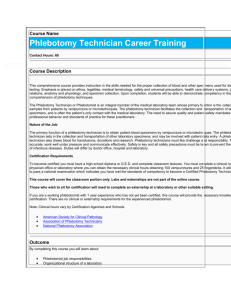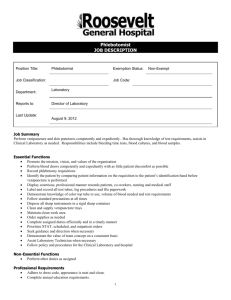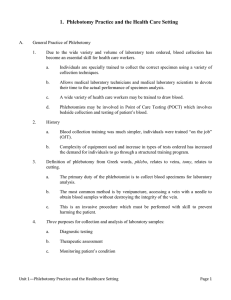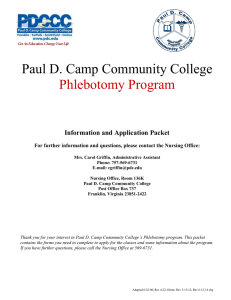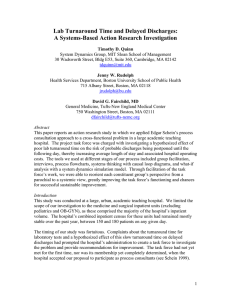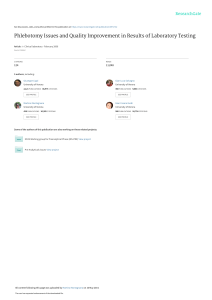Phlebotomy And The Health Care Setting Part 1
advertisement
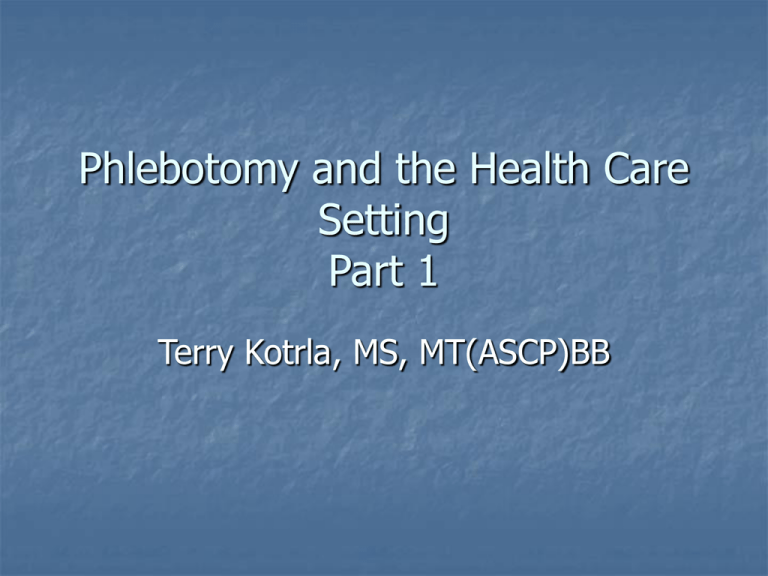
Phlebotomy and the Health Care Setting Part 1 Terry Kotrla, MS, MT(ASCP)BB General Practice of Phlebotomy There are over 25,000 possible laboratory tests, with around 500 performed in most institutions. http://www.ascls.org/labtesting/index.asp Phlebotomists allow technicians and technologists to focus on testing blood. POCT – testing at bedside, may be performed by phlebotomist History On the job trained – leads to bad habits being handed to next generation Due to complexity formal training programs developed. National certification available History (continued) Phlebotomy from Greek words, phlebo, relates to veins, tomy, relates to cutting. Opening a vein to collect blood Three purposes for collection and analysis of laboratory samples Diagnostic testing – what’s wrong with the patient? Therapeutic assessment – is the drug at the right therapeutic level? Monitoring patient’s condition – is the patient getting better? Professional Ethics Principles of right and wrong conduct for the profession. Do no harm intentionally Perform according to sound ability and judgement. Do what you’re trained to do, no more. Deal with patients assigned, not those you’re curious about. Keep all patient information confidential. National Phlebotomy Association Represents the laboratory. Gain and apply knowledge. Maintain accuracy, reliability and reproducibility of results. Respect patients bill of rights. Perform specified skills as defined by the hospital or laboratory standards Professional Behavior Character attributes for phlebotomists include: Sincere interest in health care. Accountability for doing things right. Dedication to high standards of performance. Propensity for cleanliness. Pride, satisfaction, and self-fulfillment in the job. Professional behavior involves doing the right thing when no one is watching. Working with Health Care Team Members Improving technical skills. Effective communication skills Participation in decision making Problem solving Communication Skills in the Patient Care Environment Patient’s will in first 30 seconds make a judgement Critical to have all supplies available pleasant facial expression, neat appearance, and professional manner. Introduce yourself and state your mission Remain calm, compassionate and professional Thank patient Communication issues in the home and ambulatory settings More length introduction and explanation. Location of sample collection area Must know location of restroom and bed. May need a phone to clarify orders. Procedure must be fully explained. Meticulous patient identification. Must ensure care of puncture site. Patient Interview Inpatient – MUST use 3-way ID Ask patient their full name Compare to information on requisition Compare requisition to armband No armband NO draw Outpatient settings require some additional information. DOB DL Social Security Number Teaching Patients Patient must cooperate for successful procedure Must be given instructions, best to do verbal and written Must have questions answered Define “fasting” or “NPO” if necessary and reasons. Timed testing must be clearly explained Communication Strategies communication loop: sender, receiver and filters. Filters are damaging to effective communication Filters Verbal Communication Language barriers. Must translate medical terminology Use simple, honest terms look for facial expression indicating understanding. If patient extends arm indicates understanding and agreement Verbal Communication Hearing disabilities/impairments English as a second language write down instructions Learn sign language Use non-verbal cues like sign language Find an interpreter Use Age appropriate language Be aware of tone of voice and inflection Emergency situations require exceptional communication skills. Nonverbal communication. Positive body language Smiling Good grooming Erect posture Face to face Zone of comfort Negative body language/distracting behaviors. Rolling eyes Nervous behaviors Deep sighs Crossed arms, Wrinkled forehead Throwing things around Chewing gum Yawning Name the Emotion Listening skills Lets patient know that your are truly interested. Does not depend on intellect or intelligence Tips for active listening. Concentrate on speaker Use the silent pause Use phrases such as “I see”, “Oh”, periodically Keep personal judgments to yourself. Verify with feedback, paraphrase. Mentally summarize Sense and address non-verbal signs Maintain eye contact Encourage patient to expand Paraphrase to ensure understanding Posture Phlebotomy is done standing up, good posture essential to protect back and neck. Stand erect, avoid slouching. Appear relaxed. Grooming Physical appearance communicates impression. Neat, clean hair. Clean, well groomed fingernails/hands. Uniform or business casual clothing. Clean, pressed lab coat. Personal hygiene. Bathe regularly Wash hair Use deodorant Brush teeth, use mouth spray or breath mints through out the day. No perfume or after shave Good health habits Nutrition- eat right Exercise regularly Get enough rest Benefits improves attitude, Improves appearance helps reduce stress. Quick Tips for Dealing with Stress Follow the "G-E-T S-T-R-E-S-S F-I-T" plan for a healthier, more enjoyable life. Here are 12 easy-to-remember tips on how you can bring stress and fitness into your life. Keep them handy and review them often. Give yourself a break. Get a good night's sleep. Get away from it all. Eat a healthy diet. Talk it out. Spend time with family and friends. Take a course. For fun or self improvement. Relax with a good book, a great movie or your favorite music. Exercise. Walk. Jog. Swim. Go to the gym. Set priorities. Schedule your time. Find alternative sources of satisfaction. Increase your awareness of what causes you stress. Take action! Address the person or situation that's causing you stress. And, if you're still not sure how to manage, talk to your health care professional Protective Equipment and Clothing PPE is NOT optional Employers MUST provide Includes: gowns, gloves, masks, laboratory coats and face shields. Safety equipment for processing and disposing of samples. Due to latex sensitivity, a variety of gloves in appropriate sizes must be provided. Patient’s Bill of Rights Respectful and considerate care Accurate information Informed consent. Patient refusal of blood test Privacy Strict confidentiality Advance directives Information about the identity and role of personnel involved in his or her care. Information about research procedures involved in his or her care Billing Issues in Specimen Collection Deliver quality of care regardless of the demeanor of the patient. Laboratory tests and results are strictly confidential. All records must be secured and accessed only by those individuals who need them. Patient has the right to know your name, position (especially if you are a student), description of procedure, and ultimately has the right to refuse. Document any unusual occurrences, especially confrontations. Family, visitors and significant others May be more difficult to deal with than the patient. Make requests or demands that are not part of your job duties. Refuse requests to get food or water, as patient may be NPO, have them contact the nurse. Ask there cooperation in reassuring the patient. You can ask family/visitors to step outside during blood collection if necessary. Physicians, priests, chaplains Have right to privacy with patient Leave and come back later. If timed or STAT request ask permission to collect specimen. Health Care Organizations Primary care facilities maintain and monitor normal health and prevent diseases through immunization. Secondary care have doctors who are specialists in a particular group of diseases, organ systems or one organ. Tertiary care provides highly specialized care, geared to treating unusual or complex problems and utilize sophisticated diagnostic instruments. Acute care hospital, hospital stay of 30 days or less. Long term care, stays longer than 30 days Ambulatory care. Home health services Classification of Hospitals Mission Bed size Ownership: federal, state, teaching or nongovernmental Length of stay Type of care provided. Location. Relationship to other health facilities. Department of Clinical Laboratory Medicine Composed of two major areas: Clinical pathology analyzes blood, body fluids, and biopsy materials Anatomic pathology involved in autopsies, cytology and surgical pathology. Clinical Laboratory Improvement Act of 1988 http://www.cms.hhs.gov/clia/default.asp Established regulations concerning qualifications of personnel, periodic inspections, proficiency testing, and investigation of complaints Laboratory testing classified according to complexity and personnel standards. Waived Moderate complexity tests High complexity tests Laboratory Director - medical director A pathologist with extensive education in pathology. Aid the patient's physician in the correlation of laboratory results with disease states. Assist in setting up lab protocols and determining the "menu" of laboratory testing to offer. Involved with interpretation of tissues such as those obtained during biopsy, surgery, autopsy and bone marrow. All problems or abnormal results obtained by the techs are referred to the pathologist. Laboratory Director - Administrative Technologist Title held will be dependent on facility - Lab Manager, Chief Technologist, Technical Director. May be OJT or have additional education in management and administration. Oversees administrative and technical services such as establishing lab policies and procedures, hiring lab workers, maintaining the budget, providing orientation/training of new employees, providing continuing education (CE) for staff and assigning duties based on qualification of the staff. Technical Supervisors Larger hospitals have large laboratory sections requiring a supervisor with extensive experience and education in a lab specialty. They aid the lab directory by preparing work schedules for their department, ordering departmental supplies, providing training, maintaining Standard Operating Procedure (SOP) manuals, assist in budget preparation, perform employee evaluations, discipline, hiring and firing of personnel. Clinical Laboratory Scientist (CLS), Medical Technologist (MT) B.S. in laboratory science or biologic science which must include didactic and clinical training in laboratory medicine. B.S. plus one additional year in a hospital based program. B.S. which includes clinical laboratory science education, either a 3+1 or 2+2. These individuals perform all bench work using basic to advanced techniques. Perform preventive maintenance (PM) on equipment, troubleshooting, performs and evaluates quality control (QC), participates in continuing education, and teaches CLS and CLT students. Clinical Laboratory Technician (CLT), Medical Laboratory Technician (MLT) Has obtained education through a hospital based 2 year certificate program or associate degree at the college level. Under the direct supervision of a CLS performs routine tests and procedures. CLTs free up the CLS to trouble shoot equipment or perform advanced or complex procedures on patient samples. Phlebotomist H.S. graduate or equivalent. Training varies - OJT or structured program. Collects blood specimens from adults, children and babies using appropriate technique and equipment. Identification of the patient is the most critical step. Must understand and follow to the letter all precautions related to the collection of blood specimens, whether others follow or not. May also be responsible for starting and collecting specimens for glucose tolerance tests (GTT), bleeding times, blood cultures, instructing patients on these procedures as well as the proper collection of urine and semen samples, as well as delivering and processing specimens in the lab. Must be able to deliver specimens in a timely fashion, maintain accurate records/logs, and exhibit professional conduct and attitude at all times.
